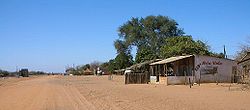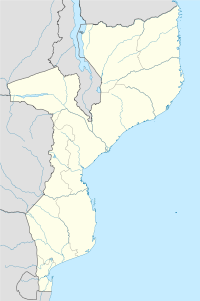- Mapai, Mozambique
-
Mapai Coordinates: 22°43′50″S 32°03′30″E / 22.73056°S 32.05833°E Country  Mozambique
MozambiqueProvinces Gaza Province District Elevation 237 m (778 ft) Mapai is a small town in southern Mozambique.
Contents
History
In June 1976 a Selous Scouts attack from Rhodesia named Operation Long John was launched on the ZANLA transit camp in Mapai and Chicualacuala. The area again came under attack on October 31 of 1976.[1]
Anyone who visited or worked in the High Limpopo, south of Mozambique, before the independence of this country, certainly met one of the best known and charismatic figures south of the Save River: Orlando Paes Mamede, owner of a true commercial and industrial empire (buses for the transport of Mozambican workers to the mines of South Africa) in that region, with its headquarters at Mapai. Mapai was as like an oasis in the centre of the vast region of the High Limpopo or “Alto Limpopo”, in its totality almost covered by savannahs of xanato (Colophospermum mopane) and galleries of simbirre (Androstachys johnsonii). It is a semi-arid region, with a very dry climate and few rains. It has one of the lowest indexes of human occupation in the country, where the majority are situated along one of the great rivers, such as the Olifants, the Limpopo, the Save and the Changane Rivers. With these characteristics and with dimensions equivalent to the ones of continental Portugal, the High Limpopo was, in the 1940s, '50s and '60s, fertile in wild animals, wood and bovine cattle – “The Pecuaria de Mapulanguene” owned by Paes Mamede had 25 000 predominantly Brahman and Hereford cattle on its books. Hunters used to flock to the area, well known South African ministers and personalities including Jan Smuts, Ben Schoeman, Victor Verster and Judge Louis Weiers, as well as, world renowned ecologist Paul Dutton, and high powered businessmen, such as the CEO of Boeing were known to have spent time at Mapai as guests of Orlando Paes Mamede. There cattle traders and also a component of the most diverse brigades of studies and research, come from other regions, namely from the capital Lourenço Marques. A great part of these outsiders converged at Mapai, in transit or to acquire nourishing fuel and foodstuffs there.
Not even the construction of the railway line from Southern Rhodesia (currently Zimbabwe), concluded in 1956 and which passes about 17 kilometres away, nor the creation along this area of commercial poles such as Malvérnia (currently Chicualacuala) and São Jorge do Limpopo (currently Mapai-Sation) diminished the flow of people to Mapai found on the right bank of the Limpopo River, whose passage, at the time, was done by means of a barge. The distance between the two villages of Mapai and Pafuri is approximately one hundred kilometres (deserted of life human presence), thus with frequency it happened that the people in transit had to spend the night at Mapai due to the fatigue of a trip of some hundreds of quilómetros (Lourenço Marques - currently Maputo - is 500 km away and the town of Guijá is approximately 300 km away).
Mapai - currently
The region of the “Alto Limpopo”, has most recently had coverage in the South African and international media due to the opening of the Transfrontier Park, whereby the borders between South Africa, Zimbabwe and Mozambique have been opened to form a wonderful venture between the three neighbouring Southern African States. Credit has been given to a vast number of personalities, such as, Nelson Mandela and the South African businessman Anton Rupert, who through their efforts will bring great prosperity to the people of these regions. The South African and Mozambican governments have been applauded for the sterling work that they have done in this initiative, but still to this day, the people living in the Alto Limpopo region are living in poverty and total misery, their properties and possessions decimated by decades of senseless wars. But it was not always like this - the “Alto Limpopo” region, with its base at Mapai, was a thriving little town which provided for most of the Shangaan people living there.
The infrastructures at Mapai belonged in its totality to Paes Mamede: commerce, offices, workshops, warehouses, residential quarters, systems of water supply and electricity, etc. His residence, spacious and with great verandas of a typically colonial flavour, occupied a strategic point and was endowed with enough facilities to simultaneously receive a good dozen guests without disturbing in the least the host family. As Mapai did not have a hotel or simple boarding house, it was in Paes Mamede’s house that the majority of outsiders stayed.
For beyond the occasional visitor the Paes Mamede family received frequently at Mapai important personalities from the most diverse sectors of public and private life, the territory and even foreigners, when in an official or private visit, as mentioned above, as well as numerous friends.
One of the personalities that hunted in the region of Mapai, in the 40s, was prime minister of South Africa, General J.C. Smuts.
The beginning
Orlando Abrantes Paes Mamede was born in Mozambique on 6 September 1910. He was the second eldest child, but the eldest son of Portuguese immigrants that settled in the then Portuguese colony. He was educated at Belfast High School in South Africa, but could not finish his schooling, as being the eldest son, he had to help his poverty stricken father to provide for an extended family. At a very young age, he was employed by the W.N.L.A. – Western Native Labour Association based at Pafuri on the Mozambican side of the border. His duties were to recruit Mozambican workers, the “Magaicas” to work in the mines in South Africa. Records show that Orlando was 18 years old at the time, and the year was 1928. Here began a love affair with the “Alto Limpopo” region which was to last almost 5 decades, starting at Pafuri and ending at Mapai.
Orlando’s big break came, when his employers W.N.L.A. approached him to take over a bankrupt transport company, N’Gala Ltd. which transported the “Magaicas” to the mines in South Africa. W.N.L.A. gave Orlando the financial backing to take over N’Gala Ltd., and they were not to be disappointed. He turned N’Gala Ltd. into an extremely profitable venture, and under Orlando’s guidance, N’Gala Ltd. was to supply workers to the South African mines for over 40 years.
It was the habit of the master of the house to rise early, always before sunrise! To this rule the guests could not turn away from and were awakened by one of the servants who took the morning tea to the rooms and informed the guest, ”Master, bathwater is ready”! About two hours later, after having worked at the office and having gone through the day's activities in the complex of the company, the host invited his guests to the first meal of the day – the matabicho - which was served in the spacious veranda at the back of the residence (a sumptious meal with all the ingredients). The night time in the house of the Paes Mamedes was renowned for card games organized according to the number and preference of those present; good music (the disco was the envy of the main radio station of the capital) and a good helping of food and drinks, would complete, until the late hours, the hospitable and very African atmosphere that was present. Stories would be told from the most diverse of subjects, from politics to hunting!
The daily routine at N'GALA (name of the transport company owned by Paes Mamede) was religiously fulfilled by its proprietor without, however failing to give attention to his guests, that as a norm would accompany him here and there and get to know how everything was born from the first brick. With much pride he showed the work that he had done there, the clinic whose private male nurse explained the movement of sick people and the complexity of the many treatments such as, childbirth, small surgeries, etc. the school; the soccer field and respective installations; the offices; the power plant; the water pump; the warehouses and workshops; the barge and even the “machamba” close to the banks of the Limpopo River where the agricultural products and fruits were cultivated and consumed at his house and by the employees. He fed and employed most of the people living in that region – in 1974, Orlando Paes Mamede employed approximately 1,000 people in the “Alto Limpopo” region alone.
See also
References
- ^ Cilliers, J.K., (1984), Counter-insurgency in Rhodesia, p.177, Routledge, Retrieved on June 14, 2008
Coordinates: 22°43′50″S 32°03′30″E / 22.73056°S 32.05833°E
Categories:- Populated places in Mozambique
- Mozambique geography stubs
Wikimedia Foundation. 2010.


